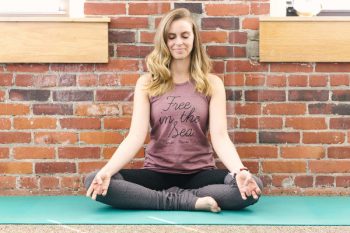Guest writer for Wake Up World
The best time to start meditating is now. Meditation can help quiet the mind, focus your thoughts, and promote general well-being. Best of all, anyone with a few free minutes can start meditating today. Even if you have never meditated before, don’t be intimidated. Follow the 10 easy steps below, and you will become a meditation expert in no time!
How to Meditate for Beginners
- Find your motivation to start.
- Pick a peaceful, quiet place.
- Choose relaxing clothes and a comfortable pose.
- To start, set a timer for two minutes.
- Concentrate on your breathing.
- If your concentration is interrupted, refocus on your breathing.
- Do a body scan by focusing on different areas of your body.
- End your meditation with a positive ritual.
- Remember not to overthink it. Just enjoy the journey.
- Make it a habit.
The Step-by-Step Guide to Meditation
While there are countless meditation techniques and practices, the steps below offer a simple way to begin. Remember, while meditating, there is always room for improvement and a chance to learn something new. Try to enjoy the journey as you hone your meditation skills.
1. Choose to Start
Meditation starts with you. No matter your age or physical condition, meditation is always within reach. What is required on your part is the decision to begin. If you need some motivation, then try thinking about the reasons why you want to try it in the first place. Meditation can relieve stress and anxiety, promote physical and mental well being, and even be a spiritual experience. Find a quiet moment to write down what you are hoping to get out of it and go back and read it anytime you need some motivation to meditate.
2. Pick Your Location Wisely
Your environment is critical to cultivating the right experience. Try to find a peaceful, quiet space that helps you feel relaxed. While a calm bedroom, tranquil garden, or dedicated meditation space is ideal, it’s not always possible. When the optimal location is not available, remember, your car or even work desk can serve as your very own meditation retreat. The most important thing, especially when first starting out, is finding a location where you have the freedom to meditate for at least two minutes without interruption.
3. Get Comfortable With It
Before you can completely clear your mind, you will need to limit as many distractions as possible. Even small irritations will become distracting once you begin to meditate. Scan the area before you start and consider the type of pose you will be in, the clothes you are wearing, and your surroundings in general. Turn off your cell phone and anything else that might be disruptive.
Pick a Pose
Meditation works in nearly any position. Sitting, standing, and laying down are three basic poses that are great for first-time meditators. Select your starting posture based on comfort and whether or not you can hold it for a few minutes at a time. For most people, a good starting position is sitting cross-legged, hands resting on the legs, and eyes closed.
Clothes
Any clothing can work for meditation, but again, comfort is key. Many people enjoy light, loose-fitting clothes when they meditate, but you can wear anything you find relaxing. If you can’t decide what to wear, throw on your favorite pair of pajamas or comfortable workout clothes.
Chairs and Pillows
Meditation can involve long periods of sitting, especially as you progress. Seasoned meditators will typically have a dedicated cushion or mat in their home, but these are not necessary when you’re first starting out. Choose a comfy blanket or pillow or a sturdy, well cushioned chair to maximize comfort for extended meditation sessions.
Sounds and Smells
Many other factors such as sounds and smells can help set the stage for a positive meditation session. Some prefer adding aromas in the forms of incense, essential oils, or scented candles, while others like to avoid sensory distractions altogether. Whatever you choose, just make sure the air you are breathing is fresh and clear of any toxins or pollutants. Natural sounds like wild animals or a babbling brook can also enhance or distract depending on the individual. Try a variety of settings to find out which works best for you.
4. Set a Timer
Meditation does not need to be a long process unless you want it to be. If you are just starting out, then begin with small increments of time. Setting a timer is very helpful for beginners because it can help keep your focus on breathing and not on the clock. To start, set the timer for two minutes, and do your best to stay focused and in the moment. As your confidence builds, try extending the timer by 30 seconds every session until you are meditating for five minutes or longer.
5. Focus On Your Breathing
One of the best ways to begin the practice of meditation is to focus on your breathing. Choose your pose and follow your breath as it flows from your nose into your lungs and out again as you exhale. Some find it helpful to count breaths, but it isn’t necessary. Concentrating on your breathing will help your mind focus as it adjusts to the silence. Even seasoned meditators pay close attention to their breathing as a way to be more mindful.
6. Return When You Wander
Most meditation practices aim to clear the brain of all thoughts and be more mindful. However, it is natural and even inevitable that your mind will wander or fixate on rotating feelings and physical sensations. Getting lost in these distractions is entirely normal, but not the goal of meditation. When this happens to you, recognize that your mind has wandered and try to refocus on your breathing.
7. Scan Your Body
Towards the end of each meditation session, take the time to do a body scan. During this scan, focus on different areas of your body. Ask yourself how you feel, and pay close attention to any part that may need healing. Shift your focus from your breathing and gradually move your attention from your toes up through your feet and legs. Eventually, you will reach every area of your body. Similar to your breathing, return focus when your mind wanders.
8. End Your Session on a Positive Note
Carry your mindfulness through to the end of your session. Slowly get up and take note of how you feel. Breathe in deeply and gently adjust your body and mind. Creating a personal ritual to end each session may be helpful. Ending rituals could include reciting a personal mantra or finishing with a light exercise or walk.
9. Don’t Overthink It
Don’t spend your meditation time worrying whether or not you are doing it right. It may take a while for you to become proficient, and that is ok. Just keep at it, have fun, and enjoy the journey.
10. Repeat Often
Meditation can help support a healthy body and mind. It promotes healthy blood pressure, a happy mood, and strengthens coping skills.[1, 2, 3] However, to start seeing the benefits you will need to meditate regularly and make it a habit. Try picking a time and place every day where you can dedicate two to five minutes to meditate.
Meditation Aids
As you continue with your meditation journey, you may benefit from additional help and advice along the way. As meditation has gone mainstream, meditation aids of all kinds are more available.
Guided Meditation
Guided meditation is an excellent option for many beginners. Many audio and video guides are inexpensive or even free online. Depending on where you live, local guided meditation classes may also be available. During these guided meditation classes, instructors will walk you through what to do and how to do it. In-person classes can also provide additional support from like-minded meditators.
There Is an App for That
Thanks to modern technologies, there is a constant stream of new resources to help you meditate better. Many phone apps can help you start or perfect the practice of meditation. With new apps coming out daily, you will have many options to choose. Look for an app that’s in a comfortable price range and focuses on a technique you want to improve. Apps are especially beneficial for first-time meditators looking to track their progress.
Your Meditation Journey
Have you tried meditation? Leave a comment below and let us know what helps you meditate and how it improves your physical and mental health.
Article sources:
- Shi L, et al. “Meditation and blood pressure: a meta-analysis of randomized clinical trials.” J Hypertens. 2016. Accessed 3 Jan 2018.
- Goyal M, et al. “Meditation programs for psychological stress and well-being systematic review and meta-analysis.” JAMA Intern Med. 2014;174(3), 357-368. Accessed 3 Jan. 2018.
- Nidich S, et al. “A randomized controlled trial on effects of the transcendental meditation program on blood pressure, psychological distress, and coping in young adults.” American Journal of Hypertension. 2009;22(12), 1326-1331. Accessed 3 Jan. 2018.
Recommended articles by Dr. Edward Group:
- The Link Between B-12, Brain Function and Memory
- The Top 10 Detox Herbs
- Learn How to Lower Cortisol Levels Naturally
- Study Finds Antidepressants to be Depressingly Ineffective
- The 9 Best Fermented Foods for Your Gut
- 14 Foods that Cleanse the Liver
- Top 5 Foods for the Pineal Gland
- The Importance of a Kidney Cleansing Diet
- The 9 Best Herbs for Lung Cleansing and Respiratory Support
- 7 Best Foods to Support Kidney Function
- How Fluoride Damages Pineal Gland Health
- 10 Uses for Organic Oregano Oil
- Lung Cleanse: 10 Ways to Detox Your Lungs
About the author:
Dr. Edward F. Group III (DC, ND, DACBN, DCBCN, DABFM) founded Global Healing Center in 1998 with the goal of providing the highest quality natural health information and products. He is world-renowned for his research on the root cause of disease. Under his leadership, Global Healing Center earned recognition as one of the largest natural and organic health resources in the world. Dr. Group is a veteran of the United States Army and has attended both Harvard and MIT business schools. He is a best-selling author and a frequent guest on radio and television programs, documentary films, and in major publications.
Dr. Group centers his philosophy around the understanding that the root cause of disease stems from the accumulation of toxins in the body and is exacerbated by daily exposure to a toxic living environment. He believes it is his personal mission to teach and promote philosophies that produce good health, a clean environment, and positive thinking. This, he believes, can restore happiness and love to the world.
For more, please visit Global Healing Center.

If you've ever found value in our articles, we'd greatly appreciate your support by purchasing Mindful Meditation Techniques for Kids - A Practical Guide for Adults to Empower Kids with the Gift of Inner Peace and Resilience for Life.
In the spirit of mindfulness, we encourage you to choose the paperback version. Delve into its pages away from screen glare and notifications, allowing yourself to fully immerse in the transformative practices within. The physical book enriches the learning process and serves as a tangible commitment to mindfulness, easily shared among family and friends.
Over the past few years, Wake Up World has faced significant online censorship, impacting our financial ability to stay online. Instead of soliciting donations, we're exploring win-win solutions with our readers to remain financially viable. Moving into book publishing, we hope to secure ongoing funds to continue our mission. With over 8,500 articles published in the past 13 years, we are committed to keeping our content free and accessible to everyone, without resorting to a paywall.








